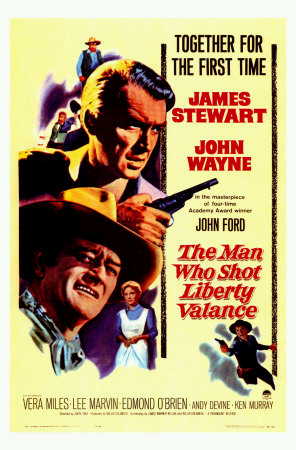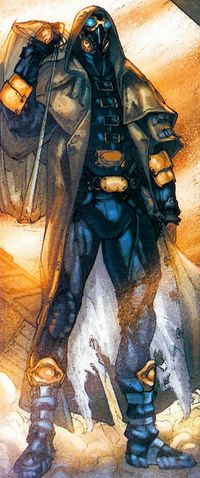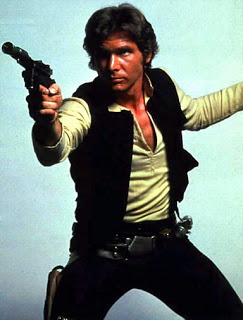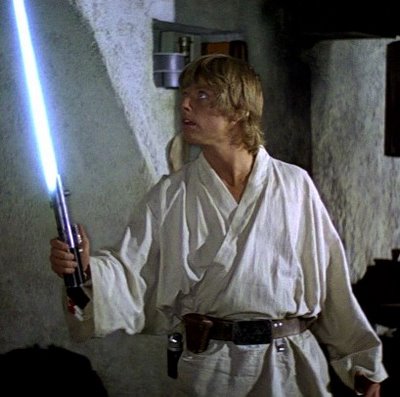
If I’m going to be talking about Star Wars’ integration with genre stories, it would be best if I first distinguished between two aspects of genre. One aspect is the core concepts of the genre — the features that make the genre what it is as a genre and control the types of stories told in that genre. For the Western, this might mean the idea of the frontier as an unpeopled or underpeopled area being settled by hardy pioneers, the idea of man vs. his environment, civilization vs. the state of nature, revenge and justice, and the centrality of the individual — in conflict with another individual, in conflict with society, or standing up alone for justice when no one else will. These are core concepts around which the genre revolves. The John Wayne/Jimmy Stewart classic The Man Who Shot Liberty Valance is directly concerned with the clash between civilization and the lawless frontier. High Noon showcases Gary Cooper as the only man in town willing to stand up to a villain at the risk of his own life. The same theme is the subject of both the original and remake of 3:10 to Yuma. Butch Cassidy and the Sundance Kid focuses on individuals who find themselves unable to fit into society and take refuge in an increasingly retreating frontier. These core concepts are what make Westerns Westerns, the things that all Westerns are ultimately about in one form or another, the stories Westerns are telling.
The second aspect is the trappings of the genre — the features that do not necessarily make a story part of the genre themselves, but are commonly found throughout the genre, often signal the genre to the general public, and can be used outside the genre to evoke it without necessarily changing the sort of story being told. For Westerns, this means elements like cowboy hats, horses, ranches and herds of cattle, mining towns, crooked land barons, saloons, barfights, the cavalry, drinking and gambling, a desert setting, nomads who wander from town to town, sheriffs versus bandits and outlaws, Indians, and quick-draw showdowns in the street.

My point is not necessarily that there is a hard and fast distinction between two types of genre elements, but that I wish to draw a distinction between telling a genre story and using trappings from the genre to tell a different kind of story. As I already explained in my original post, A New Hope uses trappings from the Western genre — the frontier homestead, the dangerous natives, the cantina as meeting place, the barfight scene — to tell what is not, ultimately, a Western story. The film is not about the frontier; it just wants to establish that Luke hails from a familiar frontier setting, and use some of the Western tropes that lead to adventurous action, like the cantina fight or the Sand People attack, in the service of a space opera story. The Star Wars Tales comic Nomad, on the other hand, is a Western story set in the Star Wars universe. It is the story of an ex-soldier, Darca Nyl, who retired to a farmstead with his wife, only for her to die giving birth to their son. When a wandering Dark Jedi kills his son, Darca pursues him across the galaxy. Darca passes through a frontier mining town controlled by a corrupt boss, a forest in which he rescues a woman from a posse before realizing that the villagers are right to pursue her killer brother, and a desert ranch beset by bandits before finally engaging in a mano-a-mano showdown with the Dark Jedi in the middle of the desert. Nomad is up to its ears in Western tropes, but it is more significantly a Western story at its core — that of a loner on a quest for revenge, trying to do the right thing, struggling with his environment and with the society he comes across on the frontier of civilization.
Nomad is not the only Star Wars Western; the Tales comic Incident at Horn Station also comes to mind, as do some of the recent Dark Times arcs. John Jackson Miller’s upcoming Kenobi looks as it if may be the first Star Wars Western novel. But overall, the Expanded Universe has been much quicker to use the trappings of Westerns than to tell Western stories. This is very understandable. Most “big-picture” Star Wars novels are locked into the larger space opera storytelling format, and cannot devote themselves purely to Westen storytelling. In other stories, Western trappings are highly useful in establishing the frontier status of the Rim, but don’t play directly into the story that’s being told. The trappings — mining towns, barfights over sabacc, bandits — are plenty of fun when they’re deployed, and could arguably be made even further use of. The next time the writers need to put Han in danger on the Outer Rim, how about instead of the thousandth blaster battle, they have him caught in a stampede?

More importantly, though, I would like to suggest that EU writers take a second look at the Western as a potential storytelling format for the EU. The space opera format is getting old after the main characters have been put through a thousand iterations of it. Why not shake Star Wars stories up by branching out more aggressively to other genres? They’ve already started with Death Troopers and Red Harvest. Instead of the Jedi constantly going after Sith, how about one of them faces off against bandits on a remote world? The next time they need a story about Han in his smuggler days, consider a bounty hunter chasing him and Chewbacca across the wilderness. A lone space ranger or Jedi wandering across the Outer Rim righting wrongs could provide a compelling basis for a comic series.
The Western genre is distinctive enough that it can’t be relied upon too heavily, but it could be used much more than it has been to spice up the EU’s current slate of offerings and offer a change of pace. It is already one of the more prominent sources of flavoring to the universe in general; it may be time that writers step up from appropriating its trappings to finding ways to use its core concepts to structure stories.


